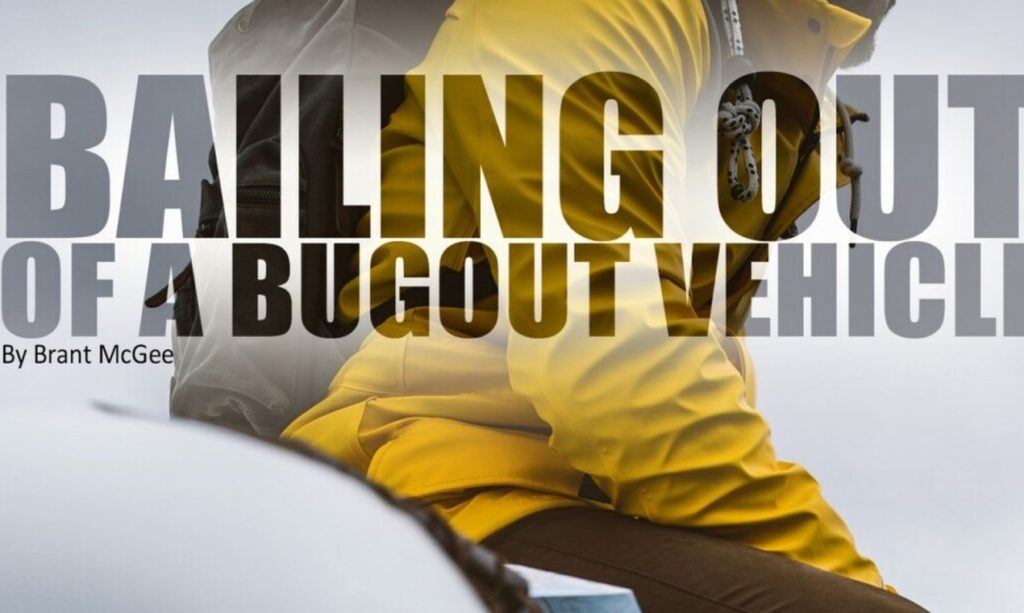In this article we are going into an in-depth rationale as to why you would consider bailing out of a vehicle. The purpose of this topic is to determine the logistics behind this desperate decision as well as the means and method of a successful dismount and egress out of whatever harm is in your way.
The reason we would need to bail out of a vehicle is as broad as the subject of bugging out itself. Maybe we have a route blocked by thugs setting up checkpoints, maybe our vehicle has been disabled, or maybe there is an immediate danger, manmade or natural, that will require us to dismount our vehicle, assemble, then flee for cover.
Whatever the case may be, people tend to open car doors and step out on the side they are sitting on, and that can be the first major threat to your safety. A threat can be as far-fetched as hostiles on one side or the other during an ambush or a busy highway that would be near suicide to step out into. Whatever the case, the driver and co-driver (if there is one) should always announce the side that everyone dismounts on. For the purposes of this article and the fact that in most cases, we would park on the shoulder to the right of traffic, this is where we will work. Just keep in mind that an ambush or dangerous situation to the right would require the occupants to flee to the left.
So now, we will go back to the moment we are loading up. During the passenger brief, the driver will explain to the occupants of the vehicle that in an emergency, everyone will dismount to the right (unless otherwise directed) and assemble at a given position. We will say that everyone meets at the 3 o’clock position. It is important to stress to everyone that if there is an obstacle at the 3 o’clock position, we will all meet at the 4, or 5 or 6 depending on where there is a safe, clear area where we all can safely meet.
Once we meet and there is a head count to ensure everyone is out of the vehicle, the driver can now determine the safest route to take. This is the part where uniformity in gear is reintroduced.
Just as it is important to have uniformity to the contents of your bugout bag, so is uniformity important in its location in the vehicle. In every single combat scenario that I have heard of where the occupants of a vehicle had to dismount in a high stress situation, if the “go-bags,” as we called them, were not practically attached to the person, they almost always left them behind. There must be uniformity and purpose in how you store each person’s kit in the vehicle, or they will be an afterthought.
Storing the bugout bags between you and your door with at least one arm looped through a strap is just about the only way you will remember to take it with you in a lurch. I can’t stress this enough: if you think you will be of the mindset to mosey back to the trunk to pull out a gear bag in a gun fight, you’ve been watching too many bad action movies.
Not only bags but other items of importance must be identified and discussed in the pre-trip briefing too. My kids can’t take a ten-minute ride without taking off their shoes, coats, or anything else to make them more comfortable. You don’t want to be lacing shoes, donning coats, or looking for the leash for your canine when SHTF.
Lastly, when you are packing the vehicle, is there anything you could accidently leave behind that would jeopardize your mission? A vehicle registration or other personal information, medication bottles with your phone or address, or even maps that you may have left behind that are marked with a bugout location can lead belligerents to your destination.
In extreme cases, you may need to decide if sanitizing the abandoned vehicle is needed to protect you and your family. I’ll leave that to your imagination, but it may include a can of gas and a lighter.
In closing, bugging out can be so much more than just hopping into the family ride and heading off to grandma’s. In the high stress game of evasion, every move you make, every piece of equipment you store, and every bit of communication between you and your passengers will be a difference in life and death.
This article was originally published in the Survival Dispatch Insider Volume 4 Issue 3.


